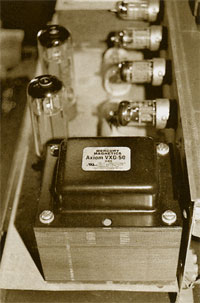
You’re are of the phenomenon… Suddenly a guitar, amp or some other new or pre-historic gizmo seems to come out of nowhere to achieve white hot, must-have status. The same thing can happen with previously unknown builders, too. Take Marshall 18W “clones,” for example… For the past 3-4 years these recreations of the rare originals were hot, hot, hot, with small custom builders sprouting and thriving from within the 18W Discussion Page. This was good for builders, good for players, and an unanticipated consequence was spawned — the rapid expansion of the cottage industry providing small amp builders with custom-made chassis, capacitors, transformers, cabinets, and just in time, an expanded range of guitar speakers developed by Eminence and Celestion. By the time Marshall jumped into the game with their own hand-wired 18 and 20W amps, the custom-built 18W wave had begun to crest and break, but there is now a new ripple on the horizon that we predict will soon form a formidable new wave among custom builders — the Vox AC30. Granted, Korg has already issued their own limited edition version of a hand-wired AC30 following the success of the British-made Vox AC30 TBX reissue, and we have reviewed the AC30 Custom Classic in this issue with backup color provided by The Radiators’ Dave Malone. While the Custom Classic is a very affordable and perfectly respectable alternative, it would be unreasonable to expect an economically built, mass produced amp to seriously rival a vintage JMI AC30 in original condition that has been competently serviced by an experienced tech. What about the original Matchless DC30 built by Mark Sampson? Great amp, but not the same. Players craving the authentic sound of an original AC30 have four choices today—find an restore an old JMI, buy a reissue and play it as is, have the transformers, caps and resistors in the signal path of your reissue amp upgraded, or buy booteek.
Well, it’s one thing to lovingly resurrect the rather Spartan Marshall 18W circuit, and quite another to tackle the original JMI design, which is much more complex, costly and labor-intensive. Furthermore, some builders may succumb to the temptation to significantly “improve” the original AC30 circuit. That would be a mistake. The successful builder will locate a vintage AC30 with truly bitchin’ tone (assuming they are capable of identifying said bitchin’ tone) and build more, per the specs revealed by blueprinting the old one. As far as we know, this has yet to happen on a meaningful scale. To date, we have located one potential candidate built by DST Engineering that will be reviewed next month. If anyone reading this believes there are more, please let us know.
 Meanwhile, let’s address the common belief that 45 year old Vox amps are too unreliable — dangerous, even — for ecstatic thrashing, let alone regular gigging. While it is true that the design of the AC30 (and AC50) provide precious little ventilation (the top vents are stingy at best), we have seen AC30s used by touring musicians and there were no flames shooting from the back (Daniel Lanois didn’t even bother with a backup). So we asked ace amp tech Don Butler (Toneman) to precisely describe the steps he takes to make a vintage Vox roadworthy…
Meanwhile, let’s address the common belief that 45 year old Vox amps are too unreliable — dangerous, even — for ecstatic thrashing, let alone regular gigging. While it is true that the design of the AC30 (and AC50) provide precious little ventilation (the top vents are stingy at best), we have seen AC30s used by touring musicians and there were no flames shooting from the back (Daniel Lanois didn’t even bother with a backup). So we asked ace amp tech Don Butler (Toneman) to precisely describe the steps he takes to make a vintage Vox roadworthy…
Don Butler: Vintage AC-30s suffer a lot from neglect. People are under the misunderstanding that all you need to do to any vintage amp is replace valves/tubes occasionally, but it requires much more than that. Here’s what I do when I get an AC30 or AC50 in for service that hasn’t had anything done to it since the day it left JMI in Darford, Kent…
Replace the dual 16uf @ 500v can, replace the 32uf @450v cap in the supply line that goes from the bottom power amp section to the preamp, and replace the dual 8uf can in the pre-amp. Replace the 32uf @ 450v cap for the Top Boost circuit (if the amp has integral Top Boost). Replace all the 25uf @ 25v cathode bypass caps (I see a lot of Vox amps where all of the main filters have been replaced but not the cathode bypass caps. It’s really just as important to replace these as well, as they set the gain for each area of the circuit they’re in). While I’m at it… Electrolytic caps have a lifespan of 7 to 10 years. After 10 years they start to deteriorate and slowly affect the way your amp functions (and not for the better, either). If you have an amp that 35-45 years old with original filters in them, well then, you’re asking for a lot of problems by not changing them. I’ve had a few vintage amps where the filters were not changed and they eventually shorted, taking the output tranny or choke of the mains tranny with them. To me they’re cheap insurance to keep your amp working properly and sounding good. By the way, the worse thing anyone can do to any amp is not turn it on for at least an hour a month. That keeps the electrolyte in it’s liquid form and prevents it from drying out and crystallizing.
Back to JMI-land — replace the output section cathode bypass cap (250uf @25v) and the four 100 ohm resistors on each EL-84 socket. These almost always drift way out of tolerance. Use 1 2att 100 ohm carbon film. On any voltage path resistor that needs to be replaced, use a carbon film. But, in the signal path, never use anything but carbon comp, otherwise it won’t sound the same. Vox always used carbon comps for everything. These days you can get 5% tolerance carbon comp resistors — in the sixties you were lucky to et 10%, and most used + or – 20% resistors.
Check each resistor with a meter. If the resistor is more than 20% off, replace it. Check the output tranny. Measure the primary side from center tap to each anode. The center tap is always soldered onto the main supply filter can. Be sure to discharge the cans before you do this!! The anodes are hooked up to pin #7, and they should read very close to each other from the center tap to each anode. Each era had different readings. A Haddon output transformer has a different primary reading than a Woden and different from an Albion as well.
Clean each valve socket, input jack and pot with Caig DeOxit D-5 contact restorer. And here’s a bit that is as important as everything else — make sure every nut, bolt, screw and pot nut is tight. You would not believe how much you can improve the noise and hum in an AC30 simply by doing this. I’ve had amps where every one of them is loose! On the 12AX& that is used for the Normal and Brilliant channels., JMI used a wire from pins 4 & 5 to ground to keep the filament supply grounded. Cut this wire off from the pins to ground. Take two 100 ohm resistors and attach them from each side of the filament supply at the pilot lamp to ground. This is what Fender did for years to make the filament supply quiet. It’s an easy “center tap” for the 6V AC filament supply.
 Check all your valves/tubes. Always use a matched set of EL-8rs and good 12ZX7s and a decent 12AU7. Spend the money for a good rectifier! You have to look at the cost of valves as an investment in your tone. Good preamp valves should last at least 10 years for NOS. I’ve seen many Ac30s with perfectly working Mullard GZ-34s that were 40+ years old. EL-84s get beat-up pretty good, but still important to buy quality valves. This is also important: With any and every JMI Vox Amp, use a Variac! Why? My wall voltage reads anywhere from 114v to 122v A.C. Vox amps want to see 105v to 110v MAX! The voltage selector may say 115v, but Sergio at Mercury Magnetics has told me many times that the real input voltage of old JMI amps was 110v max. If you plug your AC50 into the wall at 1222v, instead of your B- supply reading 470v like it should, you’ll get over 500v D.C. Most of the components are rated at 400v-500v max. By putting more in you run the risk of shortening the life of most of the components if not frying them outright. If you follow this advice and servicing recommendations and use a Variac, you should have a happy AC30 that will work for you for years without trouble. It doesn’t hurt every few months to tighten up all the screws, nuts, etc. If you tour or gig with an old AC30, you have to know at least a little bit about how to maintain your amp. If you’re too lazy to do that, then buy a new Custom classic and send it to me to mod into one that sounds very close to a JMI-era amp. There’s a good book you can get from a guy named Stephen Grosvenor in the U.K. called “A Service Engineer’s Guide to the Vox AC30 Valve Amplifier.” This just came out in June (’06).
Check all your valves/tubes. Always use a matched set of EL-8rs and good 12ZX7s and a decent 12AU7. Spend the money for a good rectifier! You have to look at the cost of valves as an investment in your tone. Good preamp valves should last at least 10 years for NOS. I’ve seen many Ac30s with perfectly working Mullard GZ-34s that were 40+ years old. EL-84s get beat-up pretty good, but still important to buy quality valves. This is also important: With any and every JMI Vox Amp, use a Variac! Why? My wall voltage reads anywhere from 114v to 122v A.C. Vox amps want to see 105v to 110v MAX! The voltage selector may say 115v, but Sergio at Mercury Magnetics has told me many times that the real input voltage of old JMI amps was 110v max. If you plug your AC50 into the wall at 1222v, instead of your B- supply reading 470v like it should, you’ll get over 500v D.C. Most of the components are rated at 400v-500v max. By putting more in you run the risk of shortening the life of most of the components if not frying them outright. If you follow this advice and servicing recommendations and use a Variac, you should have a happy AC30 that will work for you for years without trouble. It doesn’t hurt every few months to tighten up all the screws, nuts, etc. If you tour or gig with an old AC30, you have to know at least a little bit about how to maintain your amp. If you’re too lazy to do that, then buy a new Custom classic and send it to me to mod into one that sounds very close to a JMI-era amp. There’s a good book you can get from a guy named Stephen Grosvenor in the U.K. called “A Service Engineer’s Guide to the Vox AC30 Valve Amplifier.” This just came out in June (’06).
TQR: Not all power tubes can take the heat that Vox amps produce. What are your favorite choices for output tubes in old AC30s and AC50s and do you have any suggestions for keeping these amps running at lower temps?
Don Butler: AC30s — Tungsrams and Polem/Telem (same manufacturer — these are made in Poland) for NOS and EI Elites for new tubes. The Tungsrams are very clear, open sounding with nice chime on the top end and a good tight bottom. Same with the Polems, but the Polems have a bit more midrange. I find Mullards very dark and flat by comparison. I’ve tried just about all the NOS EL-84 types in my Voxes and Marshall 1974X. The EI Elites are a great sounding tube but lack just a bit of the detail and harmonics of the NOS. Still, a great sounding tube compared to the rubbish that’s being made these days.
TQR: You’re known for upgrading stock “reissue” amps. Describe the typical upgrades and modifications you make to reissue AC30s and the most recent AC30 Custom Classic.
Don Butler: I replace the output tranny with a Mercury Magnetics clone, same with the choke, as the choke is a very important piece of the puzzle. I replace every resistor and cap in the signal path with carbon comp resistors and Sozo caps. I have an audio “break-in” CD that I run into the amps after I’m done. About 4-5 times simulates the amp having been played for around 80-100 hours. I do this because every output tranny takes around 20 hours to break in, and the Sozo caps take around 100 hours to break-in. This way when my customer gets their amp back it’s as if it’s already been played for a bit and should be more open and touch responsive than if it hadn’t been played. I do also play through them when I’m done. I have to make sure they sound right. I play them again after I run the CD through them, and it’s fun to hear the actual difference!
Source: https://mercurymagnetics.com/pages/news/ToneQuest/_2007/TQRJan07-1.htm